|
Click pictures for a larger version.
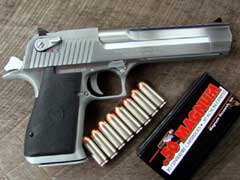

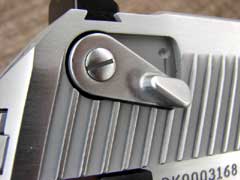
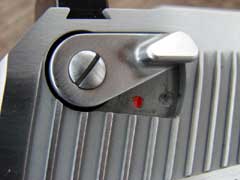


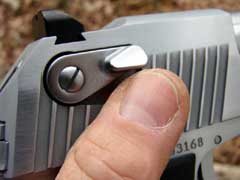
Ambidextrous safety.

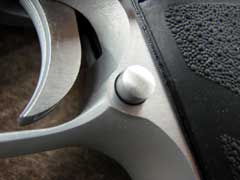
Slide lock (top), magazine release (bottom).

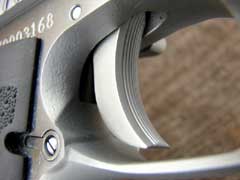
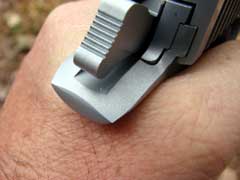


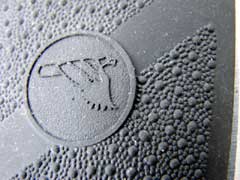
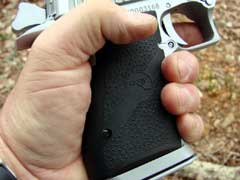
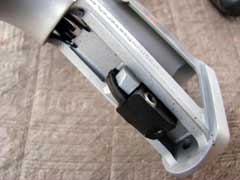


Hogue grips.
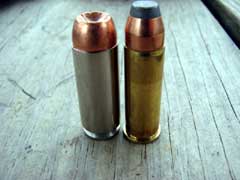
50 AE cartridge (left) compared to 300 grain 44 magnum cartridge
(right).

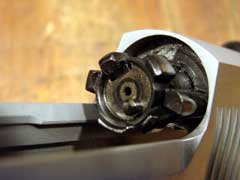
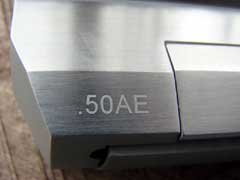
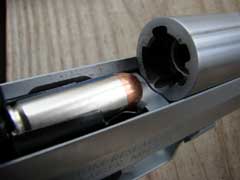

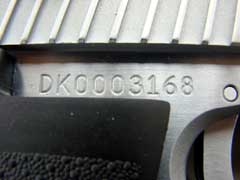
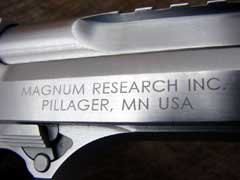

|
|
The Desert Eagle is a survivor among big bore
semi-auto pistols. While other designs enter the market and fade
away, the Desert Eagle from Magnum Research is not only
surviving, but the line of Mark XIX pistols keeps expanding with
new and unique metal finishes from which to choose. Offered in
357 magnum, 44 Magnum, and 50 Action Express chamberings, the
Desert Eagle is at the top of the food chain of semi-auto
pistols.
The Desert Eagle was introduced around
twenty-five years ago, and was manufactured in Israel for Magnum
Research. Today, most variations of the Mark XIX are built in
the United States, with only the black oxide-finished pistol
made in Israel. There are almost a dozen different variations of
the Mark XIX, with most versions available in all three
chamberings. Barrel lengths offered are six inch and ten inch,
and one Desert Eagle frame can accommodate all three chamberings
by switching magazines, barrels, and bolt heads. The Desert
Eagle uses a gas-piston system to operate the action, and the
cycling is smooth and positive.
The Desert Eagle shown here wears the brushed
chrome finish, which looks very much like stainless steel, and
is also very corrosion resistant, as is stainless. The Mark XIX
wears a set of black drift-adjustable sights, fitted into
dovetails on the slide and barrel. Integral with the top of the
barrel is a three-inch length of Picatinny rail for the
attachment of optical sights. The ambidextrous thumb safety
disconnects the trigger, preventing the trigger from dropping
the hammer. The trigger pull on this Mark XIX is much improved
over previous versions of the Desert Eagle that I have fired in
years past. The Mark XIX shown here had a nearly ideal trigger
pull, displaying just a bit of travel before releasing cleanly
with three and three-quarters pounds of resistance,
consistently.
The black synthetic rubber Hogue grips are
lightly textured, offering a secure hold without being abrasive,
and they look good on the brushed chrome pistol. The blued steel
magazine holds seven rounds, for a loaded capacity of eight. The
Desert Eagle cycles smoothly upon firing, and the slide locks to
the rear on an empty magazine. Weighing in on my scale at 69.6
ounces with an empty magazine, the Desert Eagle has a lot of
heft, which helps to dampen the recoil of the 50 AE. The tang of
the grip frame is long and wide, protecting the shooter’s hand
from any chance of hammer bite. The Desert Eagle has a
single-action firing mechanism, so the hammer must be cocked
manually, either with the shooter’s thumb or by cycling the
slide, before firing. Upon firing, the rotating bolt is locked
into the rear of the barrel. As the bullet moves forward, gas is
bled from a port in front of the chamber, acting upon the
piston, which drives the slide to the rear, ejecting the empty
case to the right and rear of the weapon. Twin recoil springs
return the slide forward, stripping a cartridge from the
magazine and chambering it as the bolt rotates, again locking
into the rear of the barrel.
For testing the Desert Eagle, the only
factory ammo that I had available was the Magnum Research 300
grain jacket hollowpoint ammo, which is pretty much all anyone
would need for hunting most anything that walks or crawls.
Magnum Research advises against the use of unplated lead bullets
in the Desert Eagle, and also against the use of hand-loaded
ammunition. However, while I did not use any cast or swaged lead
bullets, I did want to try the Barnes 275 grain homogenous
copper hollow cavity bullet in the Mark XIX. Accurate Number
Nine and Hodgdon H110 proved to give the highest velocities of
any powders tested. The Factory load pushes that 300 grain
bullet out of the six-inch barrel at an average of 1466
feet-per-second, ten feet in front of the muzzle, at an
elevation of 541 feet above sea level and an air temperature of
forty-three degrees Fahrenheit. A case full of H110 pushes the
lighter Barnes bullet a bit faster, but this load is not
pressure tested, and I can find it in no loading manual, so I
will not publish the powder charge weight. However, that is a
dandy bullet, offering excellent penetration and expansion. I
have used that same bullet in the 50
Beowulf and 500 S&W cartridges,
with excellent performance on hide, flesh, and bone. Accuracy
was superb, with the 300 grain factory load shooting sometimes
into one ragged hole, with the one and three-sixteenths inch
six-shot group pictured being representative of the pistol’s
fine accuracy. The hand loaded Barnes bullet did almost as well,
with no group fired exceeding two inches at twenty-five yards.
Picking up the Desert Eagle, it feels huge. I
have a large hand, and the pistol seems as if it would be hard
to control under recoil, but that is not the case at all. The
Desert Eagle in 50 AE is very comfortable to shoot, and is a
real pussycat in the other two chamberings. The Hogue grip
offers plenty of grasp, and the recoil is more of a big push
than a hard snap. The Mark XIX functioned perfectly, with only a
couple of shooter-induced problems. I use a high grasp on a
pistol, and shooting left-handed, sometimes the knuckle of my
trigger finger would activate the slide lock, locking the slide
open with cartridges still in the magazine. When I consciously
kept my finger off the slide lock, I had no problems, and the
weapon functioned one-hundred percent reliably. Empty cartridges
were ejected over my right shoulder, and were all found pretty
close to each other, with no damage to the cartridge cases from
ejection. Occasionally, if I allowed the pistol to torque upon
firing, an empty would brush the top of my cap, but again,
holding the pistol correctly prevented that from occurring.
The 50 AE Desert Eagle is a impressive
pistol, which is why it is often seen on television and in the
movies. There is no mistaking its profile, nor the huge hole in
the barrel. It is a bit on the heavy side for my preference of
carrying on the belt, but in a chest holster, it makes for a
fine hunting pistol, delivering enough power to take most any
game animal on Earth. Even if the owner of this big pistol never
intends to take it afield in pursuit of huge hairy beasts with
teeth and claws, the Desert Eagle is still a lot of fun, and is
in a class of its own.
Check out the Desert Eagle
online at www.magnumresearch.com.
For the location of a Magnum
Research dealer near you, click on the DEALER LOCATOR at www.lipseys.com.
To order the Desert Eagle
Mark XIX online, go to www.galleryofguns.com.
Jeff Quinn
  
Got something to say about this article?
Want to agree (or disagree) with it? Click the following link to
go to the GUNBlast Feedback Page.
|
|
Click pictures for a larger version.

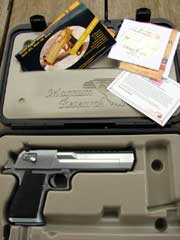
The Desert Eagle comes with hard case, seven-round mag, instructions, and
slide-disassembly tool.
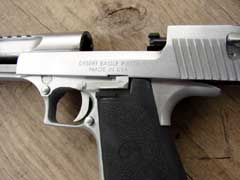
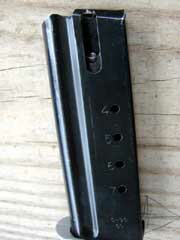
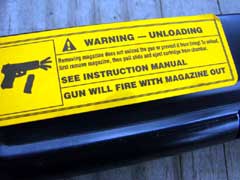


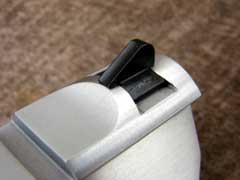
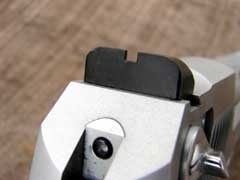

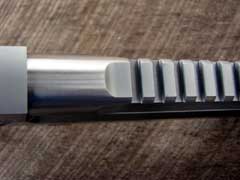
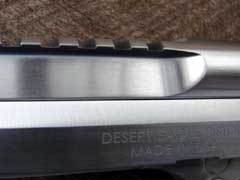
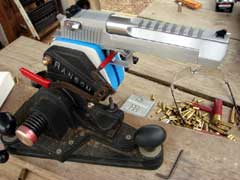
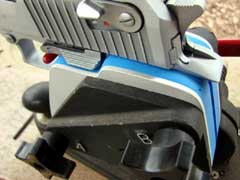
Accuracy testing was done with the welcome assistance of a Ransom Master Series machine rest.
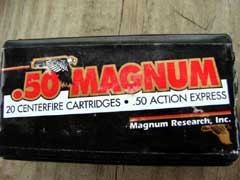
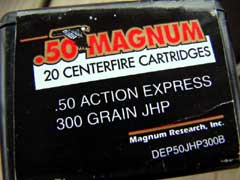
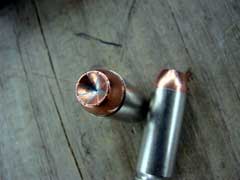
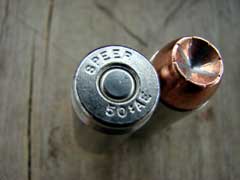


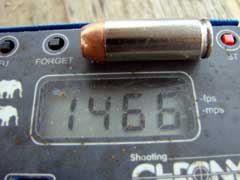
Magnum Research ammo proved to be powerful and accurate.
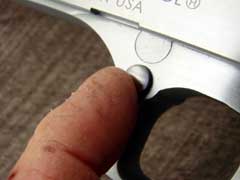

Push button and turn lever to disassemble weapon.

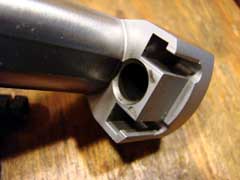
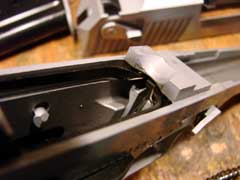
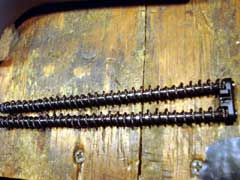
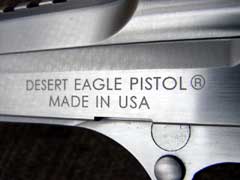
|
![]()